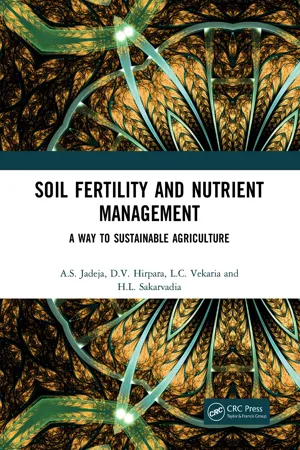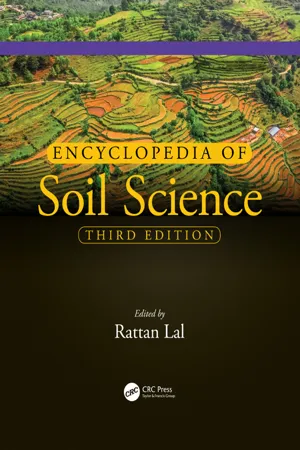Geography
Types of Nutrients
Nutrients are essential substances that organisms need for growth, maintenance, and repair. There are six main types of nutrients: carbohydrates, proteins, fats, vitamins, minerals, and water. Carbohydrates, proteins, and fats provide energy, while vitamins, minerals, and water are necessary for various bodily functions and processes. These nutrients are obtained through the consumption of food and water.
Written by Perlego with AI-assistance
Related key terms
6 Key excerpts on "Types of Nutrients"
- No longer available |Learn more
Exercise Physiology
for Health and Sports Performance
- Nick Draper, Helen Marshall(Authors)
- 2014(Publication Date)
- Routledge(Publisher)
The importance of nutrition for health was recognised over two thousand years ago by some of the earliest researchers interested in health and the human body. Since this early identification many discoveries about the nature of the foods we take into our bodies have been made. As far as this research has taken us it still remains apparent that the basis for sound nutrition lies in the adoption of a well-balanced diet. Key point It is possible, through careful selection of foods, for a vegetarian diet to provide all the nutrients necessary for successful sports performance. Traditionally, from a physiological perspective, six food components are required to satisfy and support optimal human functioning. Carbohydrates, proteins, fats, vitamins, minerals and water have been identified as essentials for healthy living. These macro-nutrients (carbohydrates, fats and proteins) and micro-nutrients (vitamins and minerals), along with water (the second most important substance, after oxygen, needed to maintain life), serve two main functions in humans: to provide the fuel for living and to maintain the structure and functioning of the body. This chapter examines the nature of these nutrient groups and their role in maintaining health and performance for all athletes. The foods that form the basis of our diet are made up from chemical elements. Over 112 elements have been identified or produced artificially, the main ones of which are shown on the inside cover of this textbook within the periodic table. Ninety-two of these elements are found naturally, and of these, 26 are commonly found in humans. Table 2.1 provides details of the elements identified in the body. As can be seen from this table, oxygen, carbon, hydrogen and nitrogen represent 96% of each person’s chemical composition. In addition, they form the basis for the three macronutrients and the vitamins necessary for a well-balanced diet - Simon Rea(Author)
- 2015(Publication Date)
- Teach Yourself(Publisher)
Macronutrients and micronutrients There are two significant differences between macronutrients and micronutrients:It is important to understand the basics of nutrition so that you can understand and analyse the information that is presented to you. Our society seems to have an obsession with nutrition, partly because everyone eats but probably also because it is related to how we look and our health. Articles about nutrition appear regularly in newspapers and magazines as well as on a multitude of resources online. However, these articles often contradict one another or are written from one author’s perspective. If you understand the basic principles of nutrition, you can critically analyse articles and make judgements about what the authors are saying.• macronutrients – carbohydrates, fats and proteins – are nutrients that are needed in large amounts in our diets; micronutrients – vitamins and minerals – are needed in our diets as well but only in smaller amounts• macronutrients yield energy, or contain calories, while micronutrients do not.Table 7.1 summarizes the main sources and functions of macro and micronutrients.Table 7.1 Main sources, functions and contribution to the diet of macronutrients and micronutrientsThis table is meant to serve as a summary, and the sources and functions of each nutrient are only a selection rather than being exhaustive. Water is often seen as being the ‘sixth nutrient’ but because it has no calorie content and very little nutritional value it has been left out of this table. That said, you could only survive for two to three days without drinking water so it clearly has a key role to play in any nutritional plan.As the table shows, there is considerable difference in energy content between carbohydrates, proteins and fats. Equal amounts of carbohydrates and fats or proteins and fats do not yield equal energy as fats contain around just over two times as much energy as carbohydrates and proteins. As a result, foods high in fat are described as being ‘energy dense’. This difference has been the cause, probably mistakenly, of fats being given a low priority in nutrition.- eBook - ePub
- FIFA(Author)
- 2006(Publication Date)
- CSIRO PUBLISHING(Publisher)
The following sections of this chapter feature soil characteristics that influence plant growth. Essential plant nutrients are also listed.The following chapters of this manual provide facts on the essential plant nutrients to help the reader gain an understanding of their role in soil fertility and productive and sustainable agriculture, including the amounts removed in crop yields, their role in plant growth, their deficiency symptoms in some important plants, their effects on soil characteristics, their fertilizer sources and their impact on the environment.Figure 1.1 This model shows how a plant uses water and nutrients from the soil and oxygen from the air to manufacture sugars (S), fats (F) and proteins (P). The more it can manufacture, the more food and fibre the plant can yield.Agriculture provides assistance to nature in three ways: • more nutrients to ensure an adequate supply for optimum yields • control of moisture through irrigation and drainage or soil practices that improve water infiltration use • good cultivation and agronomic practices to provide the best possible growing environment.Essential plant nutrient elements
Sixteen chemical elements are known to be essential for the healthy growth of all plants. They are divided into non-mineral and mineral. Non-mineral nutrients are carbon (C), hydrogen (H) and oxygen (O) and are found in the atmosphere and water. They are used in the process of photosynthesis to produce carbohydrates in this way:Products of photosynthesis, mainly carbohydrates, account for most of the increased bulk when plants grow and develop. Insufficient carbon dioxide, water or light will reduce plant growth. However, the amount of water used in photosynthesis is so small that plants show moisture stress long before water supply is low enough to have any adverse effect on the rate of photosynthesis. This is illustrated inFigure 1.1 .Mineral nutrients taken up by plants from the soil are shown inTable 1.1 ,each with its chemical symbol. The major nutrients are used in greatest quantity by plants and usually become deficient first. The micro-nutrients - eBook - ePub
Soil Fertility and Nutrient Management
A Way to Sustainable Agriculture
- A.S. Jadeja, D.V. Hirpara, L.C. Vekaria, H.L. Sakarvadia(Authors)
- 2021(Publication Date)
- CRC Press(Publisher)
CHAPTER 2PLANT NUTRIENTSA s we know that all living organisms require food for survive, growth and reproduction. Therefore, every organism takes food and utilizes the food constituents for its requirements of growth and development. A series of processes are involved in the synthesis of food by plants, breaking down the food into simpler substances and utilization of these simpler substances for life processes. Nutrition in plants may thus be defined as a process of synthesis of food, its breakdown and utilization for various functions in the body.Green plants synthesize their food materials from simple constituents (elements). Therefore, plants require a large number of elements which is taken up by the plants either from air and water or soil. In soil, the minerals (elements) are derived from minerals or are mineralized during the biological breakdown of organic matter. The mineral nutrients are taken up by the plants in the form of ions and incorporated into the plant structure or stored in the cell sap. One hundred and nine elements have been identified in the periodic table so far. Most of these exist in the earth’s mantle, earth’s crust and soil, though the magnitude of their occurrence varies. More than 60 elements are taken up by the plants. Based on their essentiality, they are grouped in to three categories viz. essential, beneficial and non essential. Before moving further, let us understand some of the key terms used in this chapter.Element: It is the simplest form of the substance. It has definite properties and can not be change in other form. For example, carbon, nitrogen, phosphorus, potassium, iron, mercury etc.Compound: When two or more elements combining to gather in a definite proportion and form third substance, the product is called compound. C + O2 =CO2 - eBook - ePub
Environmental Plant Physiology
Botanical Strategies for a Climate Smart Planet
- Vir Singh(Author)
- 2020(Publication Date)
- CRC Press(Publisher)
There are some 16 elements regarded as essential for all the plants we cultivate: C, H, O, N, P, K, Ca, Mg, S, Cu, Zn, Mn, Fe, B, Cl, Mo. However, Na, Si, and Co are also essential for some plants. Among these nutrients, some needed by plants in relatively large quantities (C, H, O, N, P, K, Ca, Mg, S, and Fe), are called major elements, or macronutrients. Some elements, on the other hand, are required by the plants in relatively smaller quantities (Zn, Cu, Mn, B, and Mo) and are called microelements, or micronutrients or trace elements.Plant-nutrient sources include inorganic and organic substances. These nutrients come from soil, water, and atmosphere—the components of the biosphere. Nutrients in water (as soil solution) are present in the form of cations and anions. Plants depend only on inorganic nutrients, making a “bridge” between the inorganic environment and organic world.Generally, soil pH between 6.0 and 7.5 is appropriate for making most of the nutrients available for the plants. Alkaline soils are appropriate for increasing Ca, Mg, Mo, and K availability for the plants. Such soils reduce the availability of Zn, Mn, and B. Acidic soils increase the solubility of Mn, Al, and Fe, which, in excess, are toxic for the plants. A common chelating agent used for Zn, Fe, and other micronutrients is EDTA. The SOM helps overcome or counteract certain toxic substances (or soil pollutants).All nutrients in a soil solution do not function independently and do not become available to plants in proportion of their individual quantities. Availability of an ion is influenced—enhanced or suppressed—by the presence of other ion(s). Deficiency of some nutrients might also occur due to mixing up and bonding between two (or more) elements, which make a salt that cannot be absorbed by plant roots. The sum of equivalents of cations in a soil solution is equal to the sum of soluble anions.Soil constantly supplies ions to the plants due to which vegetation flourishes in terrestrial ecosystems and a variety of communities comes into being. However, mineral nutrients do not occur in the soils in a fixed amount. They are dynamically added to or are withdrawn from the soil but tend to maintain an equilibrium, which is influenced by a number of environmental factors, both biotic and abiotic. Apart from N, many other minerals also recycle through SOM. A variety of minerals are there in the freshly fallen leaves, which, through decomposition, are added to the soil nutrient pool. - eBook - ePub
- Rattan Lal(Author)
- 2017(Publication Date)
- CRC Press(Publisher)
Year of discovery Macronutrients Nitrogen 1000 Potassium 250 Calcium 125 Magnesium 80 Phosphorus 60 Sulfur 30MicronutrientsChlorine 3.0 1954 Boron 2.0 1923 Iron 2.0 1860 Mn 1.0 1922 Zinc 0.3 1926 Copper 0.1 1931 Nickel 0.001 1987 Molybdenum 0.001 1938Source: Adapted from Marschner.[ 5 ]According to these rather strict criteria, 14 mineral elements have been classified as essential or plant mineral nutrients (Table 1 ). Other mineral elements that can replace mineral nutrients in some of their less specific functions, such as sodium in the maintenance of osmotic pressure, or that can compensate for toxic effects of other elements [e.g., manganese (Mn)] such as silicon, are not essential, but can be described as beneficial elements. This definition is particularly true for the mineral element selenium. There are increasing indications that this mineral element is involved in metabolic processes of stress resistance. It has been shown that selenium at low dosage can enhance antioxidative power and diminish lipid peroxidation due to enhanced activities of glutathione peroxidase and superoxid dismutase.[ 6 ] This would mean that selenium is required as beneficial element under adverse growth conditions such as drought, high temperature, or ultraviolet irradiation stress.Classification and General Function of Plant NutrientsThe 14 plant mineral nutrients can be divided into two groups: six macronutrients and eight micronutrients. In general, plant tissue concentrations of macronutrients are distinctively higher than those of micronutrients (Table 1 ). However, such division of plant nutrients into these two groups is not always that clear. In various cases, the differences between macro- and micronutrients are decisively less pronounced as indicated in Table 1
Learn about this page
Index pages curate the most relevant extracts from our library of academic textbooks. They’ve been created using an in-house natural language model (NLM), each adding context and meaning to key research topics.





